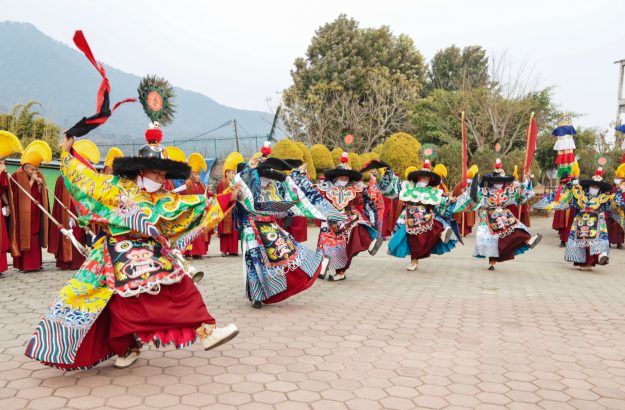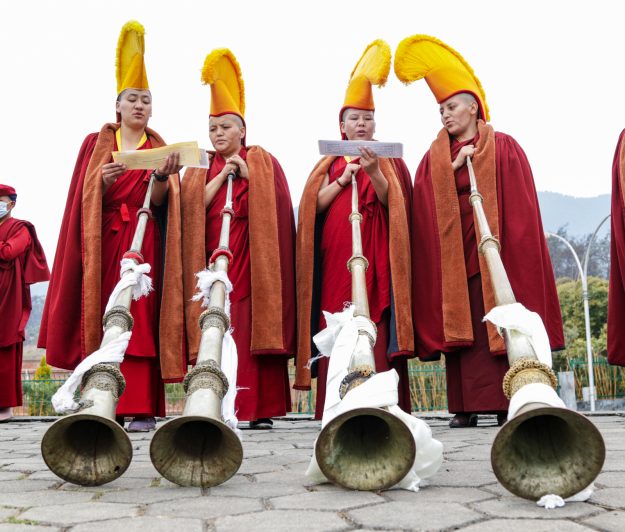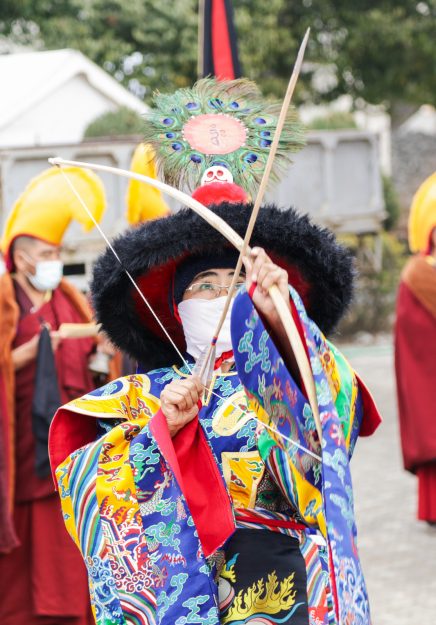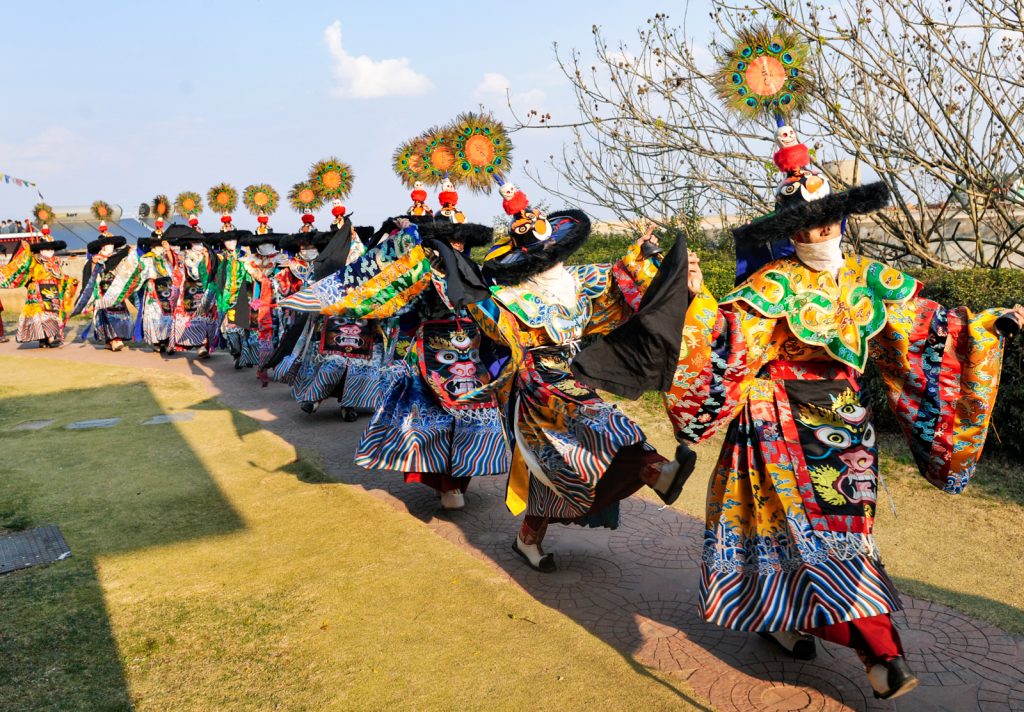A steady drumbeat sets the pace as the tinkling of ritual bells and wailing bleats of the kangling trumpets weave a rich sonic tapestry. Dressed in wine-colored robes and stately, golden, crescent-shaped hats, a group of Buddhist nuns move with ceremonial purpose through the monastery grounds to an open-air court. Some carry and play instruments. Some bear standards, victory banners, and flags. Others carry trays of ritual implements. The offering master waves a bundle of incense purifying the way for a small cohort that hauls a tray with a large terrifying effigy surrounded by a painted cardboard aura of flames. A final group emerges, robed in the dramatic costumes of Tantric Black Hat Masters. These advanced practitioners are about to dance and chant an elaborate ritual to transform the mundane world into a field of enlightened energy.
At Druk Amitabha Mountain, on the outskirts of Kathmandu, Nepal, this ritual, called torgyab, is performed by the Drukpa nuns, widely known as the Kung Fu Nuns, and no strangers to breaking glass ceilings.
In Vajrayana, or tantric Buddhism, meditations and ritual activity centering on fierce deities are performed to generate the energy needed to overcome both internal and external obstacles to spiritual advancement. Torgyab is a Vajrayana ritual performed across the Himalayas in a lead-up to Losar, the Tibetan new year, to rid the community and universe of negativity and promote excellent conditions for the incoming year. Performed on the final day of the annual drubchen (intense period of meditation, prayer, and ritual) dedicated to Vajrakilaya, a wrathful form of the Buddha Vajrasattva, the torgyab ritual invites this fierce deity of compassion to dispel obstructive forces.
The torgyab ritual is accomplished with a powerful dance called Zorcham. But the nuns—being women—were not previously allowed to perform Zorcham until recently.
In the Himalayan Buddhist monastic environment, the performance of these rituals and their sacred dances (cham) has traditionally been forbidden to female practitioners. But the Drukpa nuns—guided by the visionary leadership of His Holiness the 12th Gyalwang Drukpa, the dynamic spiritual leader of the more than 1,000-year-old Drukpa lineage of Himalayan Buddhism—started to perform the religious rituals and prayers of the lineage in 2001. Two years later, the Gyalwang Drukpa began to teach the nuns the cham dances that are part of the rituals. He later initiated their training in kung fu in 2008 after observing nuns in Vietnam practicing the martial art.
For the past 20 years, the nuns have engaged in daily worship and ritual activities that are still prohibited to women in most Himalayan monastic communities. Now, the nuns are streaming their daily worship online extending the reach and effect of their radical practice. During this finale of their annual three-day Vajrakilaya Drubchen for the removal of obstacles, the nuns performed Zorcham as part of this enacted symbolic exorcism of negativity.
By publicly performing Zorcham, these nun practitioners defy prevailing attitudes of what is feminine within Vajrayana communities. They are redefining themselves, the purview of Buddhist women practitioners, and the possibilities for girls and women everywhere─not only as full participants, but as instigators and facilitators of a more positive world.

How to Watch the Dance—and What It Means
In February 2020, I was set to travel to Druk Amitabha Mountain to witness these sacred activities and dances. But as the COVID-19 pandemic took hold, public attendance of the drubchen was canceled. I searched the nuns’ Facebook page and noticed that they were posting video clips of their activities for their followers. (The Gyalwang Drukpa has active sanghas all over the world─in Asia, Europe, the United Kingdom, and the Americas.) The Facebook posts evolved to offer complete recordings of their daily sadhana (worship) practices and special events—including the cham. Now anyone can watch the ritual online. But what is actually going on and what does it mean? Allow me to explain.
Note: video has no sound.
The long horns churn out rhythmic blasts as the officiants arrive at the ceremonial ground prepared with a pyramid of stacked wood and branches for the torgyab. The Drukpa nuns continue the procession─dancing a two-step─as they circumambulate the ceremonial ground creating the outer boundary of a sacred mandala, or buddhafield. The wrathful effigy at the center of their orbit sits on a table under the protection of a black parasol opposite the pyramid of wood.
You’ll see the Black Hat dancers wearing their tall hats and aprons painted with the face of a ferocious deity. Every aspect of the costume and hand implements is an intentional cue for the dancer and the viewer to support spiritual transformation. They dance holding a bell in the left hand (symbolizing emptiness) and a kapala (skullcup) in the right (representing the transformation of our ordinary body, speech, and mind into enlightened body, speech, and mind). The defining black hat represents a mandala. The circular black base and cupula are painted with symbols to infuse it with power.
The dancers form a semicircle and dance assertive hops, spins, and leaps. “We have to jump as wrathfully as possible,” says Lopon Jigme Tingdzin, the cham master of the nunnery. “You have to fully visualize yourself as Vajrakilaya. You are no longer an ordinary girl, a nun. All of these dualistic concepts have to be totally demolished, so while you are dancing the dances, you are 100 percent concentrated on being Vajrakilaya.”
But they are also meditating on boundless compassion, a key component to the dance, which is the culmination of three days of drubchen practices to visualize and generate oneself as this deity of fierce compassion.
When the dancers halt, the chanting nuns intone a hymn referring to the horizontal pecha strips of text that several of the nuns hold. The robust horn section plays a series of groaning blasts from the 7-foot-long instruments called dungchen. The sounding of each of the sacred instruments serves a symbolic purpose. The dungchen frequently announce the arrival of a deity or the dancers. The kangling (trumpets, sometimes made from a human tibia or femur or from metal) call or propitiate spirits or deities. The horns are all played in pairs and this is to provoke a meditation on the union of wisdom and compassion.

The video clip ends here. Another hymn commences as the offering master gestures her arm in dramatic, upward sweeps sprinkling the effigy with consecrated water symbolically demolishing its solidity and merging it into emptiness. The long horns blast as the Black Hats repeatedly toss black streamers they hold with their right hand toward the effigy to attract negative energy to it.
Another hymn is sung. The cymbals crash. The horns groan. The streamers fly.
Tension builds, and the nuns chant another hymn─this time, faster with the driving beat of the drums.
The cymbals crash. The horns groan. The streamers fly.
The chanting resumes to a faster, more insistent drumbeat. The streamers fly.
The dancers begin a slow, controlled dance to a somber chant. They lift one leg in the air and balance on the other leg while pivoting and then switch legs. Lopon Jigme Tindzin explains, “When you lift up your leg, you are freeing yourself from samsara and when the leg is lifted to the sky, it signifies a release into nirvana.” All the while they are moving closer to the effigy. The dancers stop, and the chorus takes over─chanting a beautifully harmonized, metered hymn to the beat of the drums. At its completion, the horns and cymbals announce the ritual action at hand. The dorje lopon, ritual master, takes a phurba (three-bladed ritual dagger, symbol of Vajrakilaya) and pierces two small dough effigies (symbolizing our afflictive emotions and self-concept) contained in a triangular box. Although this ritual “act of liberation” is performed by the dorje lopon, the entire “team” is fully concentrating on dissolving all dualistic concepts into emptiness and generating benevolent compassion to transform toxic forces into wholesome energy.

The dorje lopon takes a bow and shoots three arrows─upward, forward, and to the ground─to further subdue all obstacles as the chorus reprises the harmonized hymn. In this brilliantly orchestrated confluence of movement and sound, dramatic tension mounts as the dance continues─moving closer to the wrathful image.
The melody grows faster transitioning into rapid, spoken liturgy to the pulse of the cymbals. Finally, a new recitation begins to the insistent beat of the drum and the branches are lit. Within moments, a raging fire is ablaze. Several nuns assist the dorje lopon in lifting the heavy tray with the ritual effigy. They hurl the fearsome construction with its protective parasol and other symbolic objects into the fire to burn away negativity, delusion, and confusion. The dungchen sounds a continuous tone, allowing everyone to relax into the experience of auspiciousness or tashi, as everything is consumed. After a final hymn, everyone files back through the campus having accomplished the task of cleansing and preparing the environment (inner and outer) for the New Year.
***
Thank you to Lopon Jigme Tingdzin of Druk Amitabha Mountain for generously providing explanations and visual media.
Thank you for subscribing to Tricycle! As a nonprofit, we depend on readers like you to keep Buddhist teachings and practices widely available.
